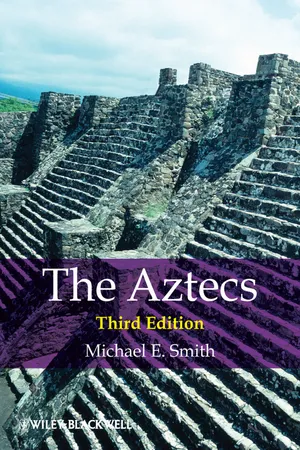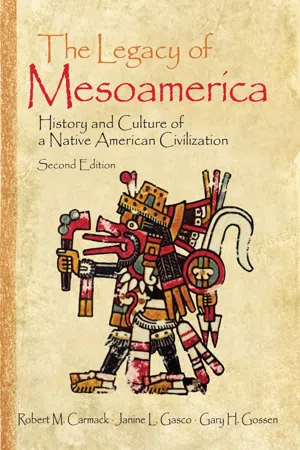History
Aztecs
The Aztecs were a Mesoamerican civilization that flourished in central Mexico from the 14th to the 16th century. They were known for their advanced agricultural practices, intricate social structure, and impressive architectural achievements, including the construction of the city of Tenochtitlan. The Aztecs also had a complex religious system and are often associated with human sacrifice.
Written by Perlego with AI-assistance
Related key terms
4 Key excerpts on "Aztecs"
- eBook - ePub
World Prehistory
A Brief Introduction
- Brian M. Fagan, Nadia Durrani(Authors)
- 2016(Publication Date)
- Routledge(Publisher)
During the next century, a political vacuum existed in the Valley of Mexico, where a series of moderate-sized city-states prospered and competed. Into this settled and competitive world stepped a small and obscure group, the Azteca, or Mexica. Within a mere two centuries, these insignificant players on the highland stage presided over the mightiest pre-Columbian empire in the Americas.The Aztecs’ history, as they told it, reads like a rags-to-riches novel. They claimed they came from Aztlan, an island on a lake west or northwest of Mexico, migrating into the valley under the guidance of their tribal god Huitzilopochtli, “Hummingbird on the Left,” who was soon reborn as the sun god himself. This was the version perpetuated by official Aztec historians and recorded by the Spaniards. Such migration legends were common in ancient Mesoamerica and should not be taken at face value. The Aztecs had certainly settled in the valley by the thirteenth century, but they were unwelcome arrivals in the densely settled valley. Eventually they settled on some swampy islands in the marshes of the largest lake in the valley, where they founded twin capitals, Tenochtitlán and Tlatelolco, sometime after 1325. Fierce and ruthless warriors, the Aztecs became mercenaries for the lord Tezozomoc of the expanding Tepanec kingdom in 1367. The Aztecs shared in the spoils of his expanding domains, soon adopting the institutions and empire-building strategies of their employer.After Tezozomoc’s death in 1426, an Aztec ruler named Itzcoatl and his exceptionally able adviser Tlacaelel attacked the Tepanecs and crushed them in one of the great battles of Aztec history. The Aztecs became the masters of the Valley of Mexico and set out to rewrite society and history itself. The great Tlacaelel ordered all the historical codices of the Aztecs’ rivals burned, creating a mythic, visionary history of the Mexica in their place. The Aztecs were now the chosen of the sun god Huitzilopochtli, the true heirs of the ancient Toltecs, great warriors destined to take prisoners in battle to nourish the sun in its daily journey across the heavens. A series of brilliant and ruthless leaders embarked on aggressive campaigns of conquest to fulfill Aztec destiny. The greatest Aztec ruler was Ahuitzotl (1486–1502), the sixth tlatoani - eBook - ePub
- Michael E. Smith(Author)
- 2013(Publication Date)
- Wiley-Blackwell(Publisher)
figure 2.1 .Pre-Aztec CivilizationsThe Aztecs were heirs to a long tradition of central Mexican urban civilizations and owed a great cultural debt to the earlier peoples of Teotihuacan and Tula. The inhabitants of Tula – the Toltecs – figured heavily in Aztec native history, but the more ancient peoples of Teotihuacan were a mystery to the Aztecs. A brief review of these earlier peoples sets the scene for the rise of Aztec civilization.TeotihuacanThe great Classic-period metropolis of Teotihuacan flourished between AD 150 and 700 in the northeastern Valley of Mexico. At its height between 450 and 600, Teotihuacan's 150,000 inhabitants, spread over 21 sq km, made it one of the largest cities in the world.3 The city was laid out according to a strict grid pattern, oriented around a central north–south avenue called the “Street of the Dead” (figure 2.2 ). The massive Pyramid of the Sun stood adjacent to the central avenue, with the smaller Pyramid of the Moon at the northern end of the street. Most people lived in large walled apartment compounds, which were tightly packed together, with only narrow alleys and passages between them. The city's rulers and elite class had larger and more elaborate residences along the Street of the Dead.Figure 2.2 Air photo of the ruins of Classic-period Teotihuacan (photograph courtesy of Companía Mexicana de Aerofoto)During the Classic period, Teotihuacan's renown and influence spread over all of Mesoamerica. Within its immediate hinterland in the Valley of Mexico, the city's rulers maintained a tight grip on economic activities and peoples' lives. Outside of the valley, Teotihuacan's armies conquered nearby peoples and forged one of the earliest empires of Mesoamerica. Beyond the reach of its empire, Teotihuacan engaged in trade relationships with many parts of Mesoamerica, and the city was viewed as an important sacred center by peoples as far away as the Maya lowlands in Guatemala.4 - eBook - ePub
- Insight Guides(Author)
- 0(Publication Date)
- Insight(Publisher)
Pre-Hispanic CivilizationThe Maya and Aztecs are the best-known cultures, but ancient Mexico contained a remarkable array of diverse, complex peoples.According to archeological research, Mexico has been inhabited for around 20,000 years. It all began in Siberia, with ancient hunter-gatherer peoples crossing the Bering Straits in search of food during the Ice Ages. From Alaska they moved south down the coast, and eventually reached Mexico and Central and South AmericaSome time around 9000–7000 BC, people in what is now Mexico first began to use a crude stone implement to grind wild corn into maize flour. This was the forerunner of the metate , the slab upon which rural Mexicans still grind corn today. By 5000 BC ancient Mexicans had begun to grow maize and beans, and around 2000 BC they began to mix lime powder with corn to create the much more nutritious nixtamal flour, the essential ingredient for making corn tortillas. These have been the staples of the Mexican diet ever since.The Mesoamerican timelineStatue of a jaguar headdress from Monte Albán. Mockford & Bonetti/Apa PublicationsMesoamerica is the term commonly used for the cultural region that in pre-Columbian times extended through Mexico, Guatemala, and much of Central America. Within it there were two main “hubs,” the Central Highlands and the southern Maya region, from Guatemala up into Yucatán, with many “offshoots” such as the valleys of Oaxaca. Our knowledge of Mesoamerican civilizations is continually changing and expanding, and has been transformed by discoveries in the last 30 or 40 yearsA common Mesoamerican historical division into “eras” has been developed. Very broadly, the first complex cultures emerged in what is known as the “Preclassic” era, from about 1600 to 300 BC; this was followed by a transitional period usually called the “Late Preclassic,” from about 300 BC to AD 250, when the growth of major cultures such as Teotihuacán or the southern Maya accelerated. The Classic era of Mesoamerica, from about AD 250 to 800, saw these civilizations reach their greatest wealth and extent, but was followed by a period often called the “Great Collapse,” when some cultures, above all the southern Maya, went into rapid decline, for reasons that are still continually debated. In the “Postclassic,” from about 1000 to the Spanish Conquest, the Maya revived on a more limited scale in Yucatán, while cultures proliferated in the Central Highlands, culminating in the empire of the Aztecs. - eBook - ePub
The Legacy of Mesoamerica
History and Culture of a Native American Civilization
- Robert M. Carmack, Janine L. Gasco, Gary H. Gossen(Authors)
- 2016(Publication Date)
- Routledge(Publisher)
A great part of the cultural diversity of Mesoamerica was an expression of an incredibly complex ethnic mosaic found throughout the region. Mesoamerican ethnic groups—often referred to in the account to follow as “peoples”—were often defined on linguistic grounds. Nevertheless, other important criteria were used to define ethnicity in Mesoamerica, such as occupation (for instance, groups of merchants or artisans), style of life (rustic vs. civilized), relations of descent (different lineage affiliations), religious cult (shared patron deities), and historical origins (such as emigration from a common sacred homeland). Ethnic “peoples” existed by the thousands throughout Mesoamerica, and they influenced all aspects of social life there.Many of the Mesoamerican city-states had their origins in ethnic groups, and each group’s particular language, deity, and general vision of the world continued to be influential long after political relations had become dominant over ethnic ties. For example, in Central Mexico most of the city-states were organized by “Chichimec” groups, the term chichimec being an ethnic designation that meant something like “nomadic peoples from the north.” The Aztecs and several other Chichimec groups spoke Nahuatl, but some ethnic Chichimecs spoke other languages such as Otomí and Tarascan. In contrast, the ethnic groups that formed the Mayan city-states of highland Guatemala were usually referred to as amaq’ , their defining criterion being emigration from a common homeland in the “East.” The Mayan Amaq’ groups spoke diverse languages, but they shared a common identity through affiliation in lineage systems that united them into kin groups of variable size.Most city-states and all imperial states of Mesoamerica were multiethnic, thus raising the question of the extent to which state religion and ideology superseded internal ethnic cultural differences. Scholars have pointed out that Mesoamerican states such as the Aztec empire did not actively seek to impose their own gods and particular cultural practices on other peoples. Recent research indicates, however, that the ruling ethnic groups tended to reformulate their particular patron deity cults to promote religious ideologies that supported broader imperial interests. Ideologies stressing war and human sacrifice were widely promoted by states throughout Mesoamerica, although the particular features of each ideology varied considerably. We also know that ethnic ideas and symbols within the core areas of the larger states were often assimilated to the dominant imperial culture, whereas in the marginal areas, ethnic groups usually remained segregated as culturally distinct peoples.
Learn about this page
Index pages curate the most relevant extracts from our library of academic textbooks. They’ve been created using an in-house natural language model (NLM), each adding context and meaning to key research topics.



